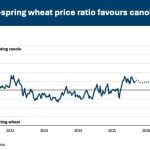An Alberta auditor general’s report says the province needs to tighten its water management.
The April 14 report said Alberta Environment needs to clear a backlog of applications for water licences and ensure holders comply with the terms of the provincial water act.
Many of the applications are nearly five years old, admitted Alberta Environment spokesperson Cara Tobin.
Applications are usually approved within weeks following a public comment period. However, some applications were never dealt with because additional information was required. The department has promised to contact the applicants to see if they still want to proceed.
Read Also

Farmers urged to be grain-safe this fall
Working around grain bins comes with risk, from farmers falling to drowning in grain: Experts have five tips to help avoid grain-related accidents this harvest.
Others were from applicants who applied for water licences when the South Saskatchewan River Basin was closed to new withdrawals four years ago.
As for licences in noncompliance, Tobin said there is a difference of opinion.
“The auditor general’s definition of compliance differs from ours,” she said.
Licence holders may be considered noncompliant if they do not use their full allocation for three years. The department will conduct a review and may recover some of the water if it’s determined that the entire amount is not needed.
Tobin said cities and irrigation districts often don’t use their full allocation because of improved conservation or lower needs in some years. However, the licence remains the same if there is a proven need for the full amount.
In 2007, concerns were raised over the Eastern Irrigation District’s application for a change of purpose on its licence. The environment minister placed the request on hold and last summer the district resubmitted its application. Statements of concern were accepted until April 19.
Tobin said there may have been a misunderstanding over what the district does with its water allocation because a number of licence holders, other than irrigators, rely on the irrigation system to deliver their water, which is legal.
“They rely on the irrigation district to support rural development,” she said.
However, NDP member Rachel Notley said the district was breaking Alberta’s water legislation because it was delivering water for purposes other than irrigation.
“The EID is trying to get government to legitimize their illegal actions after the fact,” said a party news release. “The government should deny this change.”
The Water Matters Society of Alberta also said the district’s application should be refused because it could turn the jurisdiction into a water broker.
“Moving toward being a water broker could also hamper options available to Alberta in its forthcoming water allocation review,” the society said.
“This is problematic because currently in Alberta, water for basic human needs and healthy rivers is not prioritized use under current legislation. The proposed amendment does not guarantee water to remain as a public good with public oversight.”
However, EID manager Earl Wilson said the criticisms were unfounded and probably caused by a misunderstanding about how the jurisdiction manages and conveys water.
“The people who are speaking against it either have an ulterior motive where they would like to change the water act instead of working within it, and the others don’t realize the real situation,” he said.
The proposed amount of water totals 5,000 acre feet, or 6,167,409 cubic metres, for purposes such as country residential subdivisions, campgrounds, feedlots and industries that need small amounts of water.
“We are proposing to have that available if somebody wants to relocate to the County of Newell,” Wilson said. “Then there is a chance of getting the water there.”
If the district doesn’t receive permission to offer water for other purposes, it will be forced to conduct a farmer plebiscite and send the results to Alberta Environment for final approval.
The district has the largest licence in the region to supply water to irrigated crops. It is allowed to deliver water for limited purposes as long as the quantity of water is less than 20 acre feet and is tied to a piece of land.
Under special agreements, water is supplied to 1,200 farmers on 3,000 land parcels, 1,400 farmyards and livestock holdings and 800 rural residences.
The water is also conveyed to 47 other licence holders within the district, including the city of Brooks, feedlots, industries and other municipalities.
“We are supplying legally through all these little tiny agreements and we will convert those to bigger agreements with the municipalities so it will be one agreement to a subdivision,” Wilson said.
The moratorium on new licences forced developments to approach existing licensees to obtain water. The EID has implemented widespread conservation programs to save water to expand irrigation and ensure there is enough water to survive three consecutive drought years.
The district, which had hoped to have the issue settled by May 1, charges $700 an acre to supply water under a special agreement.
“A fee for other purposes will be a similar amount,” Wilson said.
“It won’t be any more. It won’t even come close to the costs we have incurred to save the water.”















